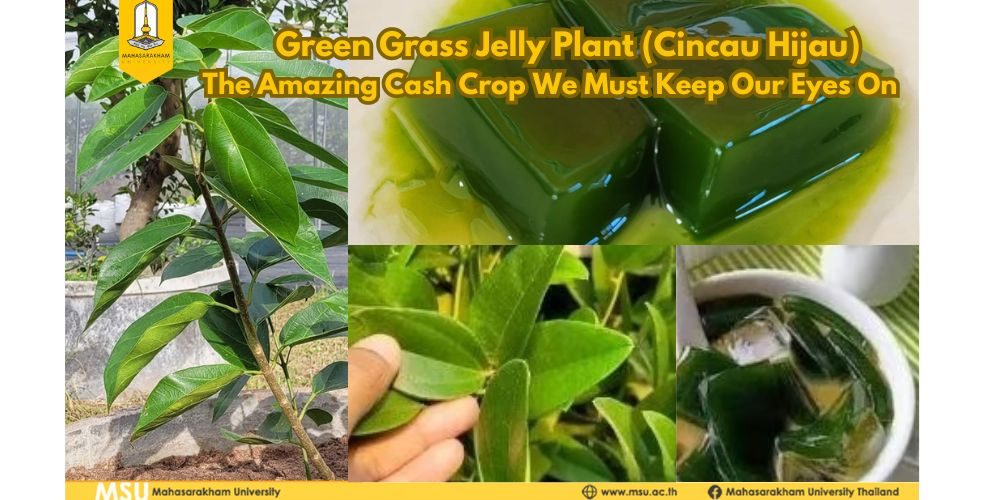Green Grass Jelly Plant (Cincau Hijau) – The Amazing Cash Crop We Must Keep Our Eyes On
Due to an interest in exotic plants and rare varieties, a study was initiated to collect and accumulate plant species from various locations for experimentation and development. This effort aims to promote knowledge among farmers in the community and provide alternative income opportunities at the household level.
“Cincau Hijau” or green grass jelly plant (also known as “Wun”), has unclear origins. Some varieties are known to originate from Indonesia and Vietnam but are not widely recognized. They are classified into two types: tree type and creeping vine type. An interesting characteristic of Cincau Hijau is that when their leaves are soaked in water and left for a while, they form a gelatinous substance without the need for any additional gelatin powder.
Researchers thus conceived the idea of propagating and cultivating these plants to study and develop cultivation methods. They see this as an opportunity to promote these plants to farmers for cultivation and processing, aiming to increase the value of their produce in the future.
Can we cultivate this plant?
While conducting experiments and trials in the agricultural farm area of the Faculty of Technology (Na Si Nuan), MSU, researchers found that Cincau Hijau is best suited to loam soil that contains organic matter and has a pH value of 6.5 – 7.5. This plant does not tolerate waterlogging and can be grown throughout Thailand.
Green Grass Jelly Plant (Cincau Hijau) – The Amazing Cash Crop We Must Keep Our Eyes On

Green Grass Jelly Plant (Cincau Hijau) – The Amazing Cash Crop We Must Keep Our Eyes On
Due to an interest in exotic plants and rare varieties, a study was initiated to collect and accumulate plant species from various locations for experimentation and development. This effort aims to promote knowledge among farmers in the community and provide alternative income opportunities at the household level.
“Cincau Hijau” or green grass jelly plant (also known as “Wun”), has unclear origins. Some varieties are known to originate from Indonesia and Vietnam but are not widely recognized. They are classified into two types: tree type and creeping vine type. An interesting characteristic of Cincau Hijau is that when their leaves are soaked in water and left for a while, they form a gelatinous substance without the need for any additional gelatin powder.

Researchers thus conceived the idea of propagating and cultivating these plants to study and develop cultivation methods. They see this as an opportunity to promote these plants to farmers for cultivation and processing, aiming to increase the value of their produce in the future.

Can we cultivate this plant?
While conducting experiments and trials in the agricultural farm area of the Faculty of Technology (Na Si Nuan), MSU, researchers found that Cincau Hijau is best suited to loam soil that contains organic matter and has a pH value of 6.5 – 7.5. This plant does not tolerate waterlogging and can be grown throughout Thailand.

Is the method of making it complicated?
Processing Cincau Hijau to increase their value often involves making it into jelly. It can then be used as an ingredient in flavored beverages, creating various visually appealing, tasty, and beneficial products.
“The method of making jelly from green grass jelly plants is not complicated. Simply take about 10-15 leaves of the green grass jelly plant and steep them in warm water (approximately 300-500 ml). Then, place them in the refrigerator for about 1 hour.”
Afterward, it can be consumed directly or mixed into chilled beverages to enhance their flavor.
Research highlights
The research promotes alternative income opportunities for farmers by enabling them to propagate and expand the cultivation of Cincau Hijau for sale as seedlings. These plants can also be processed into various health-oriented menu items, making it an intriguing and beneficial option as an ingredient in refreshing beverages or desserts. This makes Cincau Hijau a particularly innovative and unique income source for food industry entrepreneurs and farmers.
Medicinal benefits of Cincau Hijau
The green grass jelly plant possesses various medicinal benefits:
Natural Antioxidants: Cincau Hijau contains natural antioxidants, which help in neutralizing free radicals in the body.
Chlorophyll: The plant is rich in chlorophyll, which can be absorbed by the body and acts as a natural antibiotic. Its hydrophobic tail can isolate unwanted substances in the body, essentially cleaning blood vessels from impurities and blockages. Chlorophyll’s efficacy is enhanced when consumed with an adequate amount of water. Moreover, it is recommended to consume the Green Grass Jelly immediately after preparation, without adding any other ingredients, to maximize effectiveness.
Saponins: Found in the leaves of the Cincau plant, saponins are antioxidants known for their fever-reducing properties. They can be particularly effective in treating fevers caused by illnesses like influenza. To use this plant, bring the leaves boil in clean water, and allow it to cool slightly, and consume twice daily.
Anti-inflammatory: The plant’s leaves have anti-inflammatory properties, attributed to their chlorophyll content. They can help in reducing inflammation caused by bacteria or infections in various parts of the body.
How will the research be integrated into the community?
To transfer the knowledge to community enterprises, we plan to create an E-book. This format will make it more accessible to those who are interested.
Future Development of the Research
In the future, Mahasarakham University will provide ongoing academic support and development services to interested farmer groups who wish to experiment with cultivating the green grass jelly plant (Cincau Hijau). This will ensure that farmers are well-prepared to adopt and benefit from the latest advancements and best practices in cultivating and utilizing this plant.
Source: https://news.msu.ac.th/msumagaz/smain/readpost.php?mid=546




